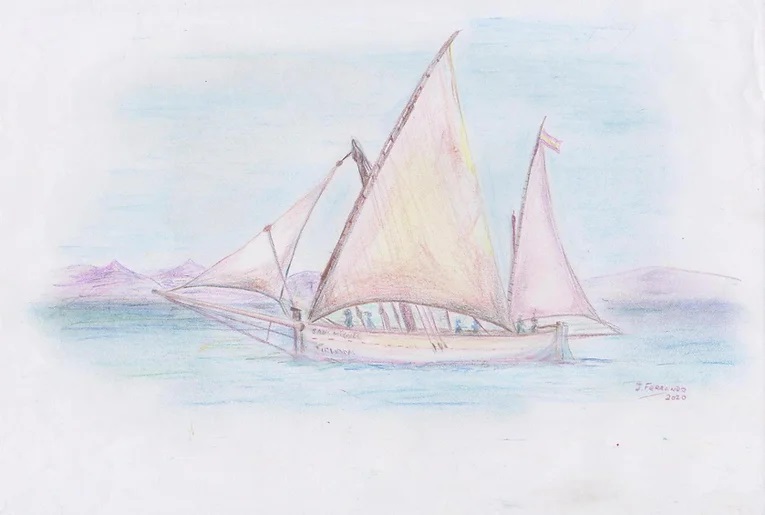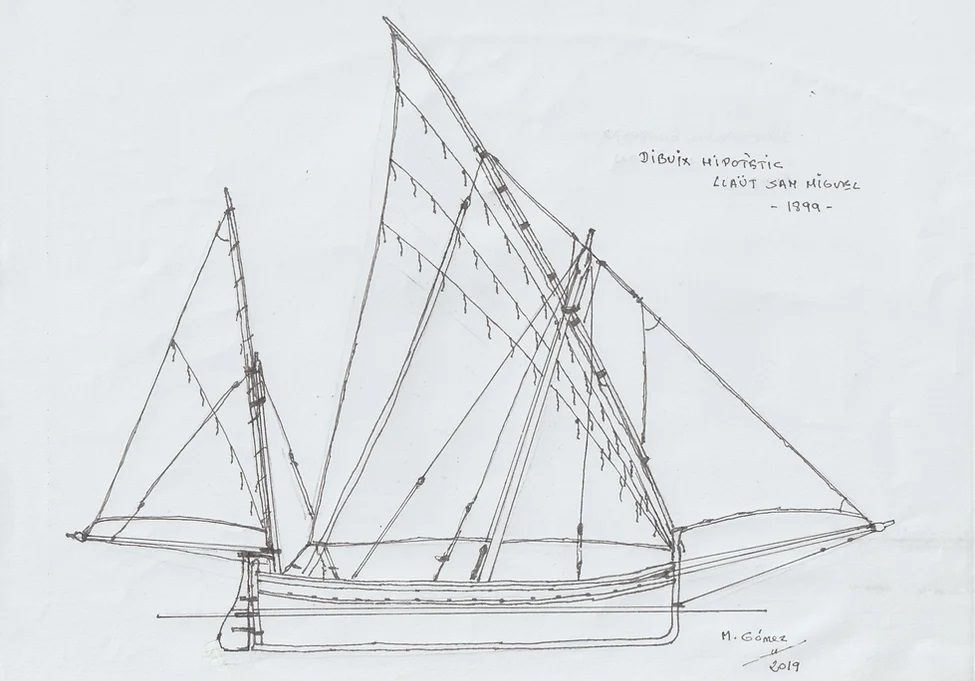San Miguel, a large 1899 llaüt
The San Miguel: a large 1899 llaüt (or: the sailboat of the expeditioners or adventurers)
At the end of the 19th century, though some steam powered vessels were beginning to sail, most vessels, especially those of small or medium tonnage, were sailing boats —llaüts, xebecs, schooners, polaccas, brigs, frigates, etc.
The llaüt was the simplest vessel among those practising coastal navigation, but it was very seaworthy and it was our own. It was and is used for fishing, nowadays for recreation and, of course, if you were from Santanyí, in those days and at other times, for smuggling.
The name, llaüt or llagut, is a word of Arabic origin, which initially gave name to a musical instrument and, due to the similarity in shape to the lute, also gave name to this type of boat. The term, with a diaeresis, was used in the lingua franca of Mediterranean seamen.
In olden days it was also known by the name felucca and was widely used even by corsairs, especially from Eivissa and Menorca. It was also known as a barca de mitjana [mizzen boat], a name specific to Catalonia which in the Balearic Islands became mizzen llagut or three mast llagut.
They could have between one and three masts or spars. The fore mast at the bow, the main mast near the centre and the mizzen mast at the stern. The typical rigging was made up of a large lateen sail, the mainsail, which was raised by a yard formed by two yardarms tied with ropes, which was hoisted up the main mast, leaning towards the bow, and was attached to the crossbar. A jib was also unfurled at the bow and boats with a fore mast were rigged with a foresail and boats with a mizzen mast with a mizzen sail which was hauled taut with a thick rope on a horizontal spar extending from one side of the stern. The flag was hoisted on the mizzen mast.
In Die Balearen, a few years before the members of S’escursionista Santañynera undertook their adventure, the Archduke mentions the llaüts being used at the time in great detail, distinguishing between the fishing llaüt, the passenger llaüt and the coastal llaüt. As far as the San Miguel is concerned, one might think it must have been a coastal llaüt, though it may have been a passenger llaüt, as practically the only difference was in the tonnage.
The crew on this type of llaüt, when devoted to shipping goods, could be up to eight men. In this case, when the only work involved was manoeuvring and navigation, and it was carrying the skipper and nine passengers, the crew may have been reduced to around half, among whom there had to be the cabin boy and, probably, the boatswain.
As a model and point of reference, we can take one of the many llaüts that shipped oranges from Sóller, chiefly, to France, the Unión. J Nicolau Bauzà wrote the history of it and included a photograph of a painting of it by Louis Roux, an artist from Marseilles, port where it usually docked. In a convent in Sóller, there is also an ex-voto of this llaüt riding out a storm in the gulf of Sant Jordi on 19 January 1891. It is worth pointing out the importance of sea trade between Sóller and French Mediterranean ports throughout the 19th century, which was at its peak at the turn of the century.
The author describes the characteristics of the llaüt Unión in detail and with pride, and I imagine our San Miguel could have been similar, though perhaps not as big: “[…] it was white, brave and very seaworthy. Seafarers enjoyed gazing on her slender silhouette ready to leap, like a greyhound, on the crest of the waves”. He also explains that the inside was distributed in the same way they were all built: three cabins at the bow with the saloon at the stern; four more cabins on each side of the saloon. The saloon served both as a living-room and a dining-room on cold rainy days while, in good weather, meals were served on deck near the stern. When a meal was served in the saloon, a round table was placed in the centre and the skipper and the sailors sat round it. The cabin boy, who usually ate separately, served the meal. The cook was known as “the buyer” and all he had to cook on was a wood-burning or coal-burning stove, usually with a handle at each side to keep it steady when the boat was rolling. While sailing they drank from a porró, which was passed around. The cutlery belonged to the boat, although each sailor would always use the same utensils, which he recognized by making a mark on them.
The ballast was kept down in the hull of the boat and above it was a floor made of branches separating it from the cargo which was subdivided by wattle, like partition-walls.
The crew would keep watch in pairs and take turns every two hours. One at the stern, holding onto the bar to steer and follow the course set by the skipper; the other, keeping an eye on the rigging and the horizon.
The Archduke explains that they use excellent material for building it, such as old, resinous pines from Formentor for the planking and holm oak from the Mallorcan thicket for the ribs. Although it must be mentioned that, according to some authors, wood from outside was also used. While holm oak, which is very strong, was used mainly for the keel, the sternpost, the stem and the cleats, Northern pine was used for the ribs and the sheathing, and the deck was built with Mallorcan pine. The masts and yards were also usually made with wood from outside. Each boatbuilder had his preferences and used other types of wood, such as wild olive, of which there is plenty, or other imported wood such as oak, teak or beech.
As for our llaüt, according to the number of people on board, it may have been about fifty spans in length and around four metres in breadth. A straight bow, typical of llaüts, with the stem, the stempin and the cathead; and a round stern, instead of ending in a point like the bow. It must have been a new llaüt, as I don’t think that, to undertake such a voyage, those well-to-do passengers would have wished to go in an old llaüt smelling of little fishes. It is unlikely, therefore, that it was a llaüt used for fishing, although it may have been now and again. So, we shall depict it rather as a coastal shipping llaüt, as I have said earlier. To try and guess the type of rigging it was equipped with, we must refer, on the one hand, to the llaüts of this type that were sailing at the time and, on the other, to the pieces of information the Journal provides about the sailing manoeuvres during navigation and when putting into port or putting out. I have already said that a llaüt could have up to three masts, each with their rigging. The essential one was the main mast with the lateen sail, “the sail”, the one which really propelled the craft forward. Although some had a fore mast, I don’t think it was the case of the San Miguel, as the fore mast, with its sail, was mostly used on larger vessels or on fishing vessels. On the other hand, it probably had a mizzen mast, as did fishing llaüts and many coastal llaüts to allow them to change the canvas for better performance depending on the winds. And although there is no mention in the Journal of either the mizzen sail or the combination of sails, this doesn’t mean it did not have such a mast with the sail furled or that it simply is not mentioned, although it could also be that it was not rigged out. The same with the jib, which is not mentioned, but it is almost certain they raised it as it greatly improved navigation.
The fact that we have some simple drawings of a craft, a llaüt, with a main mast and yard and the sail furled —in the Cash Book of the purser Llorenç Bonet and in another document, the Minutes of the Project—, does not mean it is of the llaüt San Miguel, as it seems to be a smaller craft, drawn just for decoration. Therefore, in conclusion, its rigging was probably made up of a jib-boom at the bow, a main mast with a lateen sail, where at times they raised the mainsail and at others the trysail, and a mizzen mast where perhaps the sail was not unfurled, as they did not need it. We have a similar craft today, the refurbished La Balear, which, although a llaüt, was built as a wing net boat in 1924 at the Ballester brothers’ boatyard in Palma, making it a little different; it is 13.95 metres in length and 4.56 in breadth and was built, initially, for sailing and for fishing in pairs. It is fitted with lateen rigging, with a single mast, the main mast. A similar case is the Rafael, at present in Palamós, built in 1915 at the Llompart boatyard in Palma, together with a twin llaüt, the Bartolomé, for fishing in pairs. It is 12.90 metres in length, 4.40 in breadth and 1.33 in depth; it originally displaced 14.99 GRT and was fitted with a single mast and a large lateen sail. At the bow it raised a jib or polacre with a boom extending starboard to the stem. Nowadays it is also rigged with a mizzen mast.
The San Miguel could have looked quite similar, with a little less breadth and slightly different, as it was probably a llaüt for cargo rather than for wing net trawling in pairs. It would be rigged, as I have said, as a mizzen boat.
The skipper, and probably the owner, was Jaume Antich, Cavallot, or his father, one of the most important seafaring families in Santanyí at that time. His father, mister Antoni Cavallot, was one of the people from Santanyí who went in for fishing, as did the Fesols, among the first to go from nets to smuggling. He amassed a lot of wealth and properties and a fleet of seven wing net boats. Jaume also owned one of the first pairs of wing net boats in Cala Figuera, called Primero and Segundo, which he used for fishing and smuggling.
Sailing rigged with lateen sails (or: sailing with the wind and sea rising)
Only on a sailing boat can you plough the sea with its silences and its noises and hear it breathing the salty wind. This is suggested in the poem by Ausiàs March, which Raimon set to music.
The power of sails and winds shall work my wish,
Setting a chancy course across the sea.
Ponente and Mistral rise to resist.
Levante and Sirocco fight for me
Backed by their allies Midi and Gregal
Beseeching the North Mountain Wind to turn
Its storms aside in their support, so all
Five winds may blow the way of my return
[…]
And if there is a sail peculiar to the Mediterranean Sea, it is the lateen sail, which allows for sailing in all winds, in the unpredictable, changing winds of our sea. With this sail, one can even tack against the wind, unlike square sails, which can only be raised in a favourable wind.
Lateen rigging has been used on small and medium-sized vessels, however, it is unsuitable for large ones, as it takes strong manoeuvres to handle it and requires many sailors. For this reason, it has mostly been used on xebecs, tartanes, the various types of llaüt and dinghies.
In order to sail with this rigging, the yard is hauled up one side of the mast to a suitable height and the sail, which is triangular, is unfurled. When the sail is leeward to the mast, it is called downwind sailing and, when it is windward to the mast, that is, between the wind and the mast, it is called upwind or windward sailing. Although the speed is faster when sailing downwind, depending on the weather it is much better to sail upwind.
The lateen yard can tack in different directions, in relation to three planes: vertical, which is the angle of incidence; horizontal, which is the angle of elevation; and what is called reach or concavity of the sail.
On a vessel propelled by sails, proper handling is what will allow one to sail well or badly, faster or slower, taking advantage of wind force and direction. The most important sail for the manoeuvre I am talking about is the mainsail, as the jib and the mizzen are complementary. One of the things to bear in mind is the angle formed by the sail and the wind, the other is the inclination of the yard. The position of the yard is fixed using four boltropes: the luff, the fore, the vang and the sheet.
The most important parts of the rigging of the main lateen mast on a llaüt are:
Yard: the spar on which the lateen sail is fitted to the main mast. On a llaüt of this type it is made up of two yardarms joined by a very strong (Portuguese) bowline: the bottom yardarm, which is the stronger and lower end, and the top yardarm, which is the upper and more flexible end.
Sail: it has three angles or corners, the tack, the head and the clew. The lateen sail and its yard, unlike other types of sail, allowed for three spatial movements as it is fixed to a single point.
Ropes or lines: the luff boltrope is a rope of medium thickness with a ring or buckle at the lower edge or bottom of the yard and is used to pull the yardarm towards the stern when sailing with a long wind or wanting to set the sail. The brace or braces are pairs of rope which attach the bottom of the yard to the bow. The vang is a thinner rope than the other two, tied to the top end. The sheet is used to adjust the angle of the sail.
The first thing to do is raise the yard at both sides of the mast. Depending on the direction of the wind the lateen sail is manoeuvred in different ways, combining all three movements. One must also make a distinction between the long luff manoeuvre, in which the inclination of the yard gets progressively closer to horizontal while moving towards a course before the wind, in which one attempts to make more efficient use of the sail, and the braces and the luff boltrope are manoeuvred so as to place the bottom yardarm at the best angle of incidence to the wind; and the short luff, in which the inclination is kept invariable while the yard and the sail are held as vertical as possible with the bottom yardarm over the deck on the windward side.
In order for a llaüt or any other sailing vessel to sail properly, to make efficient use of the wind, depending on the angle at which it is blowing, one moves the yard in one direction or another and raises the sail higher or lower, tightening or easing ropes, so that the sail is neither too trimmed nor too slack, neither flapping nor confined or facing the wind. Depending on where it is coming from, one can sail different courses in relation to the direction of the wind:
Close-hauled:
- Upwind or against the wind: when the craft is sailing into the wind, up to 45º (4 quarters) on either side in regard to the direction from which the wind is blowing, so that it hits port or starboard of the bow, as we would not advance if we were sailing directly into the wind.
- Close to the wind: sailing windward, between 45º and 67º (6 quarters) off the wind.
Reaching:
- Close reach: the angle the direction of the wind forms with the course of the vessel is between 67º and 90º (8 quarters).
- Beam reach: when the wind hits perpendicular to the course, that is, at an angle of 90º off the wind.
- Broad reach: the wind is not quite perpendicular but is coming from the port or starboard wing, up to an angle of 135º (12 quarters) to the direction of the bow.
Running:
- Butterflying or running wing and wing: sailing on a course where the wind is coming from between broad reach and running downwind.
- Running downwind or before the wind: the wind is coming from directly behind, completely off the wind.
- A traditional glass wine pitcher (TN)
- Translation by AZ Foreman http://poemsintranslation.blogspot.com/2015/07/ausias-march-loves-journey-poem-xlvi.html (TN)







